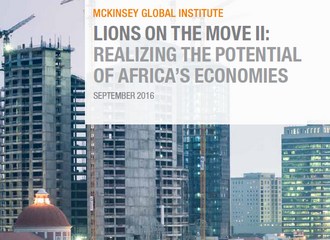Growth Perspectives in Africa: where is the continent standing?
Submitted by admin on Wed, 10/26/2016 - 10:05
The last reports published by the World Bank and the International Monetary Fund reveal a signifgicant decrase of growth on the continent. Economic growth in Sub-Saharan Africa is projected to fall to 1.6 percent in 2016, the lowest level in over two decades. That being said, the pattern of growth across countries is very heterogeneous, and some countries are continuing to post annual average growth rates of over 6 percent.
• Download World Bank Report, “Africa Pulse”
• Mc Kinsey, “Lions on the Move II: Realizing the Potential of African Economies”
A significant slowing down on the continent
After slowing to 3 percent in 2015, economic growth in Sub-Saharan Africa is projected to fall to 1.6 percent in 2016, the lowest level in over two decades. Low commodity prices and tight financial conditions, exacerbated by domestic headwinds from policy uncertainty, droughts, and political and security concerns, continued to weigh on activity across the region.
The overall slowdown in Sub-Saharan Africa's growth reflects economic deterioration in the region's largest economies, and especially South Africa and Nigeria.
Large disparities among African countries
However, as underlined by the World Bank and Mc Kinsey's new report "Lions on the Move II", the pattern of growth across countries is far from homogeneous, suggesting that Sub- Saharan Africa is growing at diverging speeds. While many countries are registering a sharp slippage in economic growth, some countries—Ethiopia, Rwanda, and Tanzania—are continuing to post annual average growth rates of over 6 percent, exceeding the top tercile of the regional distribution; and several other countries—including Côte d'Ivoire and Senegal—have moved into the top tercile of performers.
If we exclude oil exporters and countries affected by the political turmoil of the Arab Spring, growth actually accelerated to 4.4 percent in 2010 to 2015 from 4.1 percent in 2000 to 2010. In addition, long-term fundamentals are strong, and there are substantial market and investment opportunities on the table. Future growth is likely to be underpinned by factors including the most rapid urbanization rate in the world and, by 2034, a larger working-age population than either China or India.
According to Mc Kinsey report, "While the potential that Africa offers is undoubted, the question remains: will it be achieved? Businesses and governments will need to work harder to capture the opportunity. Governments will need to address the continent’s productivity and drive growth by focusing on six priorities emerging from this research: mobilize more domestic resources, aggressively diversify economies, accelerate infrastructure development, deepen regional integration, create tomorrow’s talent, and ensure healthy urbanization.
Go Further
• McKinsey, "Lions on the Move II: Realizing the Potential of Africa's Economies"
• World Bank, "Africa Pulse, No. 14, October 2016"
• I&P, "Sub-Saharan Economic Development and Outlook"
